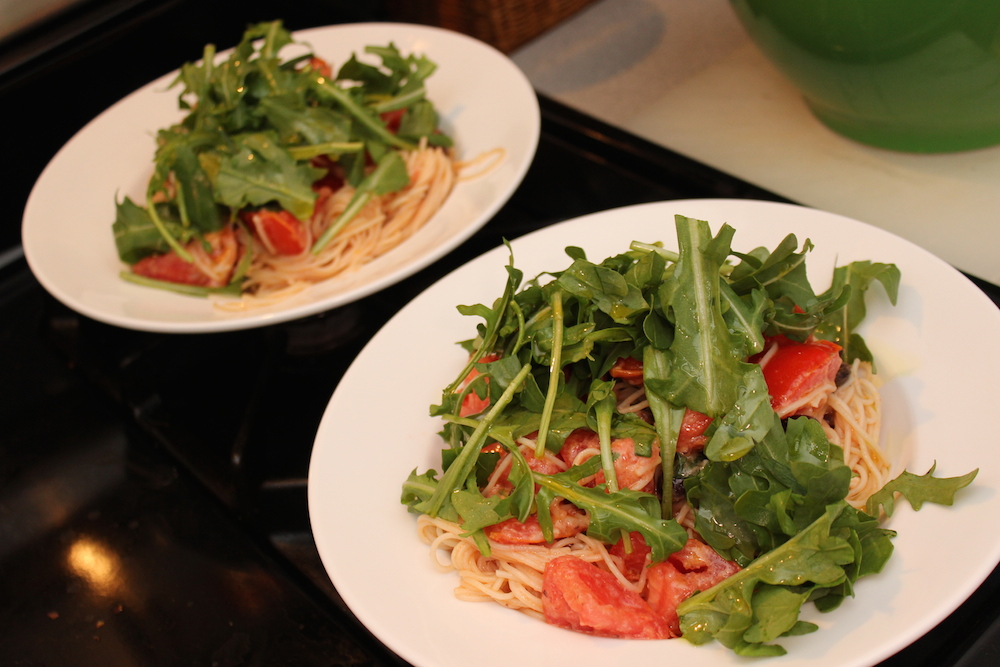
Pasta with Brie and fresh tomatoes adapted from the Silver Palate Cookbook.
In 2007 Sheila Lukins and Julie Rosso visited Toronto as part of a promotional tour celebrating the 25th anniversary of The Silver Palate Cookbook. Meeting the two authors was a big deal for me. I was just over two years into my new career as a food journalist and internet publisher and not used to meeting my heroes (I’m still not). I was more than a little star-struck when I sat down to interview them for gremolata.com. What ensued was not quite what I had bargained for. Lukins appeared to have been generously refreshed at lunch and wasn’t interested in talking about her books or food at all, but rather the charms of various rock’n’roll bars and bands. Rosso was demonstrably irritated at her former partner and co-author and focused her energies on upbraiding Lukins. Rather than a cookbook writing dynamic duo, the pair came across more like a bickering couple on the verge of divorce. But somehow, I muddled through and got a few questions in for what proved to be a short piece. If I sound like I am complaining, I’m not. It was great fun to meet the two heroines of cookbookery, and I’ll never forget that interview (especially as Lukins, who was so animated that afternoon, died two short years later in August of 2009). Nor do imagine I’ll ever stop cooking out of The Silver Palate Cookbook or, Lukins and Rosso’s equally famous second third cookbook, The New Basics.
 The recipe below is the first entry of The Silver Palate Cookbook’s chapter entitled ‘Summer Pasta’. My wife, Apple and I started to cook for ourselves as teenagers, but got serious about cooking as undergraduates in Montreal. We each loved to throw dinner parties, until events conspired such that we began to hold them together. The Silver Palate and the New Basics were more or less our Old and New Testaments, and a few recipes that we used to cook more than twenty years ago endure. We weren’t (and still aren’t) unique, and I can’t remember if this recipe comes from Apple’s repertoire or that of our close mutual friend (and match maker) Antonia. I can recall discussing it at one point in the mid-nineties, when someone decided to use cherry tomatoes instead of big field ones – a wise move for this cool summer of middling harvests. The discussion was on a dock at Antonia’s family’s camp in the North Channel of Georgian Bay near White Fish Falls, and I believe it was anticipation of that night’s dinner. Apple and I make this dish a few times every August and September, and it’s never fails to conjure up good memories.
The recipe below is the first entry of The Silver Palate Cookbook’s chapter entitled ‘Summer Pasta’. My wife, Apple and I started to cook for ourselves as teenagers, but got serious about cooking as undergraduates in Montreal. We each loved to throw dinner parties, until events conspired such that we began to hold them together. The Silver Palate and the New Basics were more or less our Old and New Testaments, and a few recipes that we used to cook more than twenty years ago endure. We weren’t (and still aren’t) unique, and I can’t remember if this recipe comes from Apple’s repertoire or that of our close mutual friend (and match maker) Antonia. I can recall discussing it at one point in the mid-nineties, when someone decided to use cherry tomatoes instead of big field ones – a wise move for this cool summer of middling harvests. The discussion was on a dock at Antonia’s family’s camp in the North Channel of Georgian Bay near White Fish Falls, and I believe it was anticipation of that night’s dinner. Apple and I make this dish a few times every August and September, and it’s never fails to conjure up good memories.
Lukins and Rosso narrate their books in the first person plural, which transfers authority from the two of them as individuals to the text itself (to mangle Beaudrillard – another relic from my 90s youth). They write about ‘Linguine with Tomatoes and Basil’:
We first had this uncooked pasta sauce when we were guests in a beautiful home on Sardinia. Such a recipe could only be the result of hot, lazy days and abundant ripe tomatoes and basil. The heat of the pasta warms and brings out the flavors of the sauce in a wonderfully subtle way. Delicious and easy.
The recipe is more a less a bruschetta mix with a pound of Brie cheese thrown in. The acid from the tomatoes makes the brie melt into the sauce in a Cheez-wizzy way. The garlic, basil, olive oil and tomatoes in the ingredient list below certainly speak of Sardinia. But the Brie? Well, of course it does, at least in 1982. No doubt bought at the supermarket in Cagliari, the fancy imported cheese tells of a lost time when French cuisine still reigned supreme; a time before Dean & Deluca, never mind Eataly. It’s a charming touch that renders the book authentic to its era and reminds us that slavish devotion to locavorism is very much a modern sentiment. I also like that Lukins and Rosso specify the use of basil leaves, as if one might not be sure which part of the plant to use, or (I guess more likely) be tempted to use dry herbs from a jar. Likewise, we are advised to use “imported Parmesan”, should we decide to opt.
I’ve tried substitutions for the Brie, like bufala or Québécois triple creams, but they don’t work nearly as well. It’s important to use very ordinary Brie, too. Brie de Meaux, does not disintegrate as well as the industrially made stuff. That’s just the way it is.
We don’t use the following recipe per se, having riffed on it for so long it’s become both second nature and discernibly different. Now we are as likely to include arugula instead, or with basil, and add a few fresh chillis – I’m not sure we’ve ever gone for the Parmesan option, either. And we play around with the pasta, too. The last time we used capelli, but anything as long or longer than penne will do. I’m reproducing what’s below without permission, but under the copyright doctrine of ‘fair use’. If you don’t have a copy of The Silver Palate, then please go buy one, if only to keep Workman Publishing’s lawyers off of our case! (In all seriousness, every kitchen shelf ought to have one, along with The New Basics.)
LINGUINE WITH TOMATOES AND BASIL
from The Silver Palate Cookbook by Sheila Lukins and Julee Rosso with Michael McLaughlin (Workman, 1982)
- 4 ripe tomatoes, cut into 1/2-inch cubes
- 1 pound Brie cheese, rind removed, torn into irregular pieces
- 1 cup cleaned fresh basil leaves, cut into strips
- 3 garlic cloves, peeled and finely minced
- 1 cup plus 1 tablespoon best-quality olive oil
- 2 and 1/2 teaspoons salt
- 1/2 teaspoon freshly ground black pepper
- 1 and 1/2 pounds linguine
- freshly grated imported Parmesan cheese (optional)
1. Combine tomatoes, Brie, basil, garlic, 1 cup olive oil, 1/2 teaspoon salt and the pepper in a large serving bowl. Prepare at least 2 hours before serving and set aside, covered, at room temperature.
2. Bring 6 quarts water to a boil in a large pot. Add 1 tablespoon olive oil and remaining salt. Add the linguine and boil until tender but still firm, 8 to 10 minutes.
3. Drain pasta and immediately toss with the tomato sauce. Serve at once, passing the pepper mill, and grated Parmesan cheese if you like.
4 to 6 portions.
 Malcolm Jolley is a founding editor of Good Food Revolution and Executive Director of Good Food Media, the company that publishes it. Follow him on Twitter or Facebook
Malcolm Jolley is a founding editor of Good Food Revolution and Executive Director of Good Food Media, the company that publishes it. Follow him on Twitter or Facebook
.

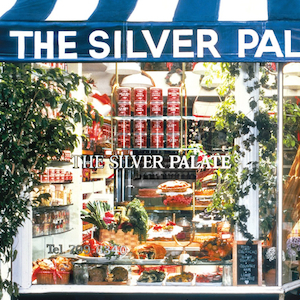

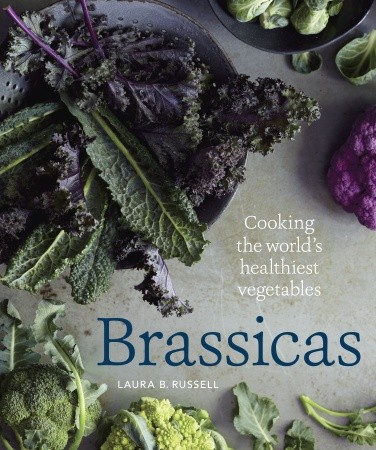
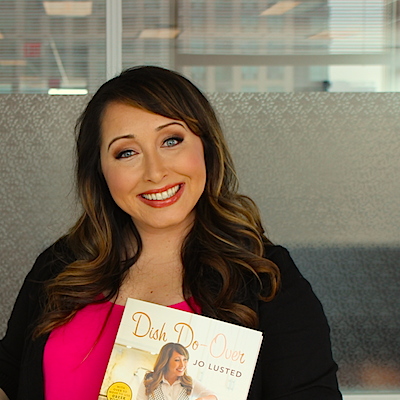

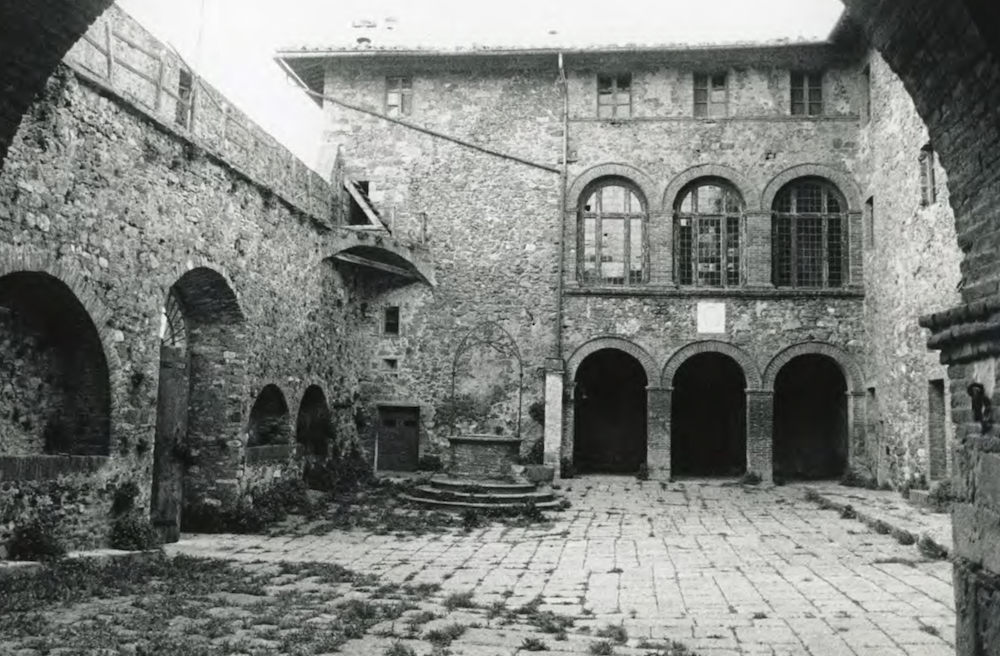

Our heroines also, but — oops. The New basics would be their third cookbook. The Silver Palate Good Times cookbook would be their second also with lots of great recipes. Cheers. Richard
I stand corrected! Apologies for the lazy journalism!
Thank you, I loved reading this. We used the Silver Palate so intensely I had to buy a new copy several years ago and we make their summer pasta all the time, in fact just last week for lunch a few days after you departed! Thank you for this!
Easy to check out, readable…heck I had to leave a commment!
Love this recipe! When you say ‘Brie cheese rind removed and torn’ do you not use the rind! Thank you kindly, Marge
Can I use penne for Brie recipeor best? . Linguine may be too messy for a ladies lunch